NANTES – THRIVING CITY AT THE MOUTH OF THE LOIRE

The city of Nantes in western France is located just 50kms from the Atlantic Ocean. Nowadays, it’s the capital of the Pays de la Loire Region, but will always be known as the capital of Brittany, when the Dukes of Brittany ruled from here until the Duchy was united with France in the 16th century. The city is home to many significant buildings, including the former Duchy’s seat of power. The lifeblood of the city is due to its location on the Loire which brought the world to its doorstep, allowing trade and industry to flourish. Today, with great art, cuisine, river islands and Muscadet wines, Nantes is a vibrant, lively city where history and the present merge to offer visitors art, culture and fun.
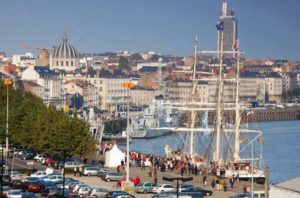
Nantes has a fascinating history. It had been known as a port on the Loire since classical antiquity. After about 1,000 years of trading, evidence of the remnants of smithies suggests local industry appeared around 900BC. Due to its desirable location, numerous local rival tribes fought for control of it until the Roman occupation. Nantes never became a large city under the Romans, since inland road transport was favoured over Atlantic routes, so the city lacked the usual Roman refinements such as a theatre or an amphitheatre. Nevertheless, the city had sewers, public baths and a temple dedicated to Mars Mullo.
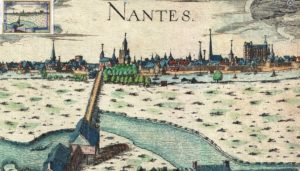
After attacks by German tribes in 275AD, in common with other Gaulish towns, the inhabitants of Nantes built a wall which was regarded as the largest of its kind. Nantes remained allied to the Roman Empire until its collapse in the 5th century AD, when the city was captured from the Visigoths in 490 by Clovis I. It was used as a stronghold against the Bretons, although under Charlemagne in the 8th century, the town became the capital of the Breton March. It was briefly seized by invading Vikings around 843 and later became part of the Viking realm until they were expelled in 937 by the Duke of Brittany.
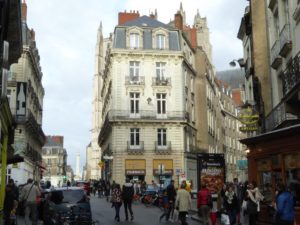
During the ensuing centuries when feudalism took hold across the country, Nantes passed several times from the Dukes of Brittany to the Counts of Anjou (the House of Plantagenet), and was involved in a war of succession which ended with the accession of the House of Montfort to the ducal throne. Nantes became the largest town in Brittany, the Montforts established their treasury and chancery there, and port traffic became the city’s main activity. Nantes began to trade with foreign countries in commodities such as salt, wine, fabrics and hemp from the British Isles, and later became the gateway to North America. Many buildings were built or rebuilt over the centuries including the cathedral and castle, and the University of Nantes, the first in Brittany, was founded in 1460.
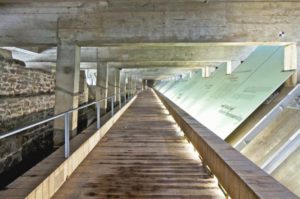
By the 1700s Nantes was the largest port in France. Local shipowners began importing sugar from the French West Indies, which was highly profitable. Plantations in these colonies needed labour to produce sugar, rum, tobacco, indigo dye, coffee and cocoa, and in 1706 the Nantes shipowners began trading African slaves. The port was part of the triangular trade whereby ships went to West Africa to acquire slaves, who were then sold in the French West Indies, and the ship returned to Nantes with sugar and other exotic goods. Up until 1793, Nantes was responsible for 42% of the French slave trade; its merchants sold about 450,000 African slaves in the West Indies.

As manufactured goods were more lucrative than raw materials, during the 18th century there were about 15 sugar refineries in the city and 9 cotton mills. Nantes and its surrounding area were the main producers of French printed cotton fabric, while the Netherlands was the city’s biggest customer for exotic goods.
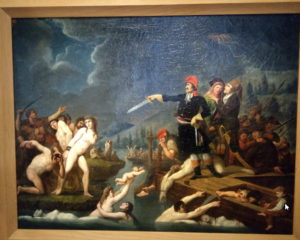
Nantes, as a bourgeois city largely based on private enterprise, initially supported some aspects of the Revolution, but on the whole, rural western France, which was Catholic and conservative, strongly opposed the abolition of the monarchy and suppression of the Church. The Revolution’s National Convention saw Nantes as a corrupt merchant city, and a bloodbath of executions ensued. Many people were guillotined, shot or drowned under a measure known as the ‘Drownings of Nantes’, which were intended to kill large numbers of people simultaneously. The authorities dubbed the Loire “the national bathtub.”
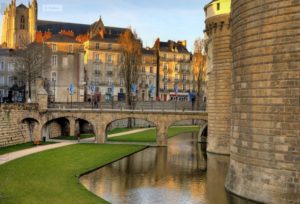
The Revolution was disastrous for the economy. The slave trade was abolished in France in 1794 under the Revolution, becoming the first European nation to do so. Under Napoleon, the Continental Blockade he imposed totally ruined trade with other European countries. Nantes never fully recovered its 18th century wealth. However, during the 19th century, Nantes became a major industrial city, with food processing, canning and especially shipbuilding which were among the largest in France. The downside of all this activity was that the embankments of the river were overcrowded with railways, roads and tramways; the channels flowing through Nantes started silting up, so that most of the channels were filled in and the water diverted, altering the urban landscape, and a number of islands in the Loire formed into the Isle of Nantes.
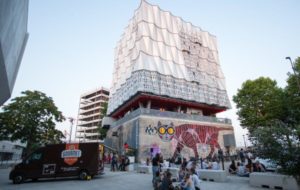
After Nantes was captured by the Nazis on 18 June 1940, many citizens were executed as reprisals for their fierce opposition to the invaders. The city endured Allied bombing raids in 1944; the Germans abandoned it, allowing it to be recaptured without a fight by the French Forces of the Interior and the US Army. Post-war, moderate prosperity returned to Nantes, but the global recession of the 1970s saw its economy stagnate, with the closure of factories and especially the city’s shipyards, which re-located to St-Nazaire. Since the early 2000s though, Nantes once again re-fashioned itself to become service-oriented, focussed on higher education institutions and facilities, and has developed a rich cultural life, advertising itself as a creative place near the ocean.
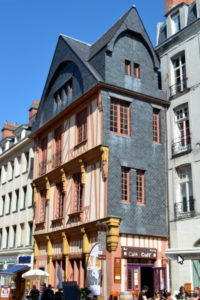
The Nantes of today is one of the most pleasant cities in France—and in fact, was voted France’s most liveable city 2 years ago. Former industrial areas have been converted to new uses for commercial and leisure purposes, a considerable amount of restoration work has been carried out on its numerous historic buildings and medieval core, and an enormous amount of green space created or restored, with 100 public parks, gardens and squares.
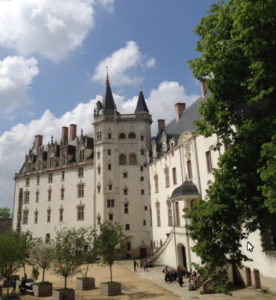
Nantes has a great deal to see and explore, and probably the best place to start would be a visit to the Château des Ducs de Bretagne, located virtually in the centre of the city. This Renaissance-style 13th century fortress is the last château on the banks of the Loire before the Atlantic. Construction was started by the last Duc de Bretagne and continued by his daughter Anne de Bretagne, who was twice Queen of France.

The Edict of Nantes was signed here under Henri IV in 1598, granting the Calvinist Protestants of France, known as Huguenots, substantial rights, in order to promote civil unity after the ferocious religious wars between them and the Catholics. The château now houses an extremely interesting urban history museum. This is no dusty or dull museum. Its light-filled rooms house not only objects but multimedia insightful exhibits detailing the city’s history over 5 centuries, including documentation of its murky past associated with the slave trade, and the city’s activities into the 19th and 20th centuries.
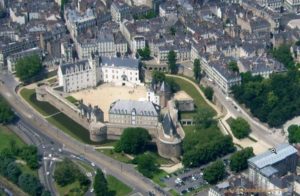
Visitors are free to walk around the ramparts which link the château’s 7 towers, and picnic at leisure along the grassy moat. There’s a very nice café located in the Vieux Donjon (the old keep), as well as a good souvenir and bookshop. Nearby is the Place du Commerce, a largely pedestrian area that offers a good array of bistros and restaurants.
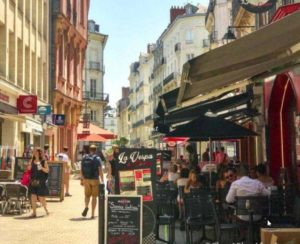
Just 250m from the château, the Place de Bouffay is the oldest district of central Nantes. This pedestrianised area features many interesting little streets and lanes that spread out from the cobblestoned Place. There are many pleasant spots to have lunch or simply a drink on the outdoor terrace of one of the cafes and restaurants. There’s also a branch of Galeries Lafayette in rue de la Marne, just a few minutes’ walk away.
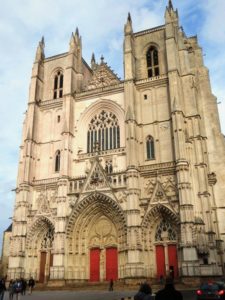
Also close to the château is the city’s cathedral, Cathédrale Saint-Pierre-et-Saint-Paul, which although not one of the major cathedrals of France, is nevertheless very impressive and worth a visit. Construction began in 1434 but wasn’t completed until 1891. It was damaged by Allied bombing in June 1944, and in 1972 a gigantic fire that started on the roof, caused serious damage, prompting a complete interior restoration. It has some very beautiful stained glass windows dating from 1500, and perhaps its most notable monument is the tomb of François II, Duc de Bretagne and his wife Marguerite de Foix, the parents of Anne de Bretagne.
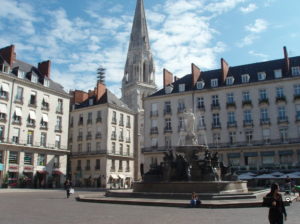
Place Royale is a grand urban square dating from the late 18th century when the city’s prosperity was at its peak. Now part of the pedestrian area of central Nantes, it’s popular for its cafés and shops. The whole area is filled with good quality shops and boutiques selling all sorts of items, from clothing to shoes to mobile phones.
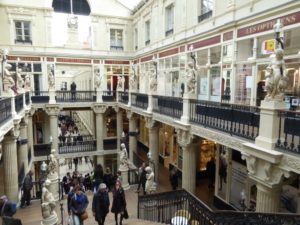
Located in the heart of Nantes, in rue de la Fosse, is the Passage Pommeraye, a flamboyant covered shopping street built in the 19th century, at a time when new covered passages were all the rage in Paris. Designed in an elegant Neo-Classical style, it’s a classified historic monument, and is especially famous for its splendid marble staircases, gilded galleries, statues, a clock and beautiful glass ceiling. The Passage Pommeraye has over 25 stylish boutiques on 3 floors selling fashion, accessories, perfumes, jewellery, patisseries, leather workshops and other must-haves. It links the higher rues Santeuil and Crébillon to the rue de la Fosse, which is 9m lower down.

The city’s magnificent Musée d’Arts, established by Napoleon in 1801, has recently reopened after a six year renovation and new extension, showcasing a splendid collection of over 10,000 works, from Tintoretto and Rubens to Monet, Rodin, Kandinksy and Chagall. The Musée offers a number of avant-garde events under the umbrella of ‘Le Voyage à Nantes’ spread across the city during the year.
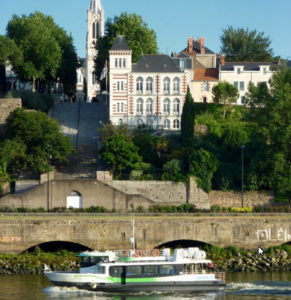
If you’re a fan of the writings of Jules Verne don’t miss the excellent museum, at 3, rue de l’Hermitage, in a late 19th century building on the side of a cliff overlooking the river Loire. He was born in Nantes in February 1828, and although he never lived at this location, the museum has a large collection of artifacts including replicas of his inventions, and other fascinating memorabilia.
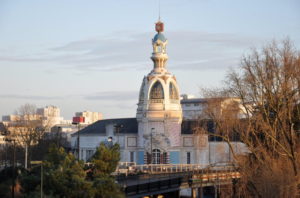
A very interesting example of a redundant industrial building being given a new lease of life is ‘Le Lieu Unique’. With a striking tower built in the Art Nouveau style, the old LU biscuit factory has been transformed into a contemporary arts and music centre. Complete with a Turkish baths in the basement, an inexpensive restaurant, waterside bar and a bookshop, the centre opened in 2000. They produce a booklet called ‘What’s On’, with a section in English, that sets out a calendar full of events held throughout the year—many of which are free. Located at Quai Ferdinand Favre on one of the banks of the river Erdre, it’s a 6 – 7 min. walk from the château.

The beautiful 19th century Jardin des Plantes (Botanic Gardens) is a green oasis just near the railway station. It covers over 70,000 sq.m., which includes 800 sq.m. of greenhouses that contain an outstanding collection of African and Asian orchids. With thousands of species of plants and flowers displayed between waterways and ponds, beautiful statues, fountains, and whimsical animals and birds “sculpted” from hedges, this is a peaceful place to take a break from the hustle and bustle of the city centre.
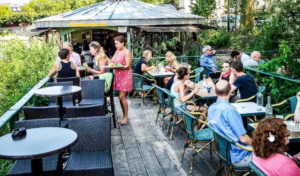
Just North West of the Jardin des Plantes is Les Bordes de l’Erdre, a tranquil neighbourhood bordering the river. The bustling city centre is barely 15 mins. walk away, but this laid-back bohemian quartier is perfect for sunset aperitifs on the Pépé Guinguette, a houseboat moored on the quay, or one of the numerous bars such as Le Bateau-lavoir or Café de l’Ile.
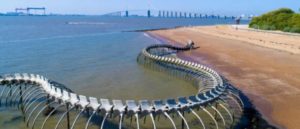
The mighty Loire estuary is a natural extension to the city that has been opening up for locals and tourists over the last few years. Three art biennales have left a heritage of around 30 monumental sculptures and installations as the river nears the Atlantic. A 3 hour cruise is a great way to relax, while watching the landscape change from industrial sites to fishing villages, farms and wetlands filled with wildlife, to the shipyards and containers at St-Nazaire. The artworks include a half-submerged house, a giant sea snake, wild animals climbing trees, and a metal tower with a house on top (that can be rented). A €5 train ride gets you back to Nantes in 30 minutes.
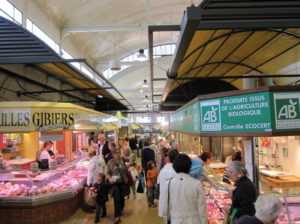
To see the best food of the area, head to the Marché de Talensac, known as the belly of the city, where everyone does their shopping. Inside the 1937 covered market hall you’ll find local specialities such as Antilles rum or lemon-flavoured gâteau nantais, and pungent curé nantais, a cows’ milk cheese. Fish and shellfish straight from the trawler—especially the lobsters, crabs, king prawns and oysters—are all outstanding. Each weekend, local farmers set up stalls outside offering an enormous range of organic vegetables.
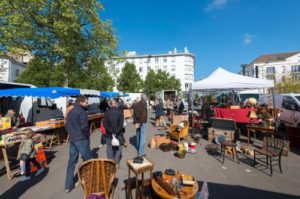
There’s also a lively flea market covering the adjoining Place Viarme on Saturdays. There are plenty of friendly bars and cafes that ring the market, such as Café du Coin, or the stallholders’ favourite, Café du Matin.
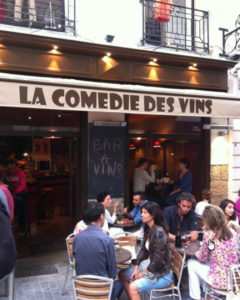
The region is renowned for producing light-bodied, crisp whites such as Muscadet and Gros Plant, which are both excellent with seafood. A very pleasant venue to sample these regional wines is La Comédie des Vins, in rue Suffren in the city centre. Unpretentious and often busy, this wine bar has an impressive choice of top-notch wines on offer. The staff is very knowledgeable and passionate about wine, and you can accompany your wine degustation with a plate of tapas or cheese.
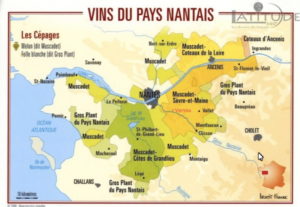
The vineyards begin just outside town, so either drive or join an organised excursion through the countryside between Nantes and Clisson. Numerous vineyards offer tastings, such as Château de Coing, set in 70 hectares beside the water.
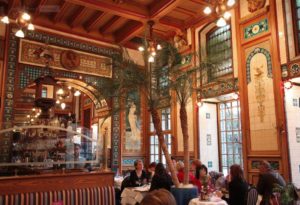
One of the longest-established brasserie-restaurants in Nantes that we can highly recommend is ‘La Cigale’. It’s classified as an historic monument for its beautiful Art Nouveau architecture and décor dating back to the year it opened, in 1895. Located on Place Graslin, in the centre of Nantes, you can sample a wide variety of top quality local produce, notably the seafood, and of course, an excellent selection of Muscadet wines.
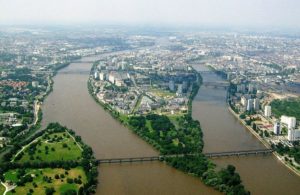
Île de Nantes is an island neighbourhood located in the city centre, surrounded by the river Loire. Part of a massive redevelopment project to rejuvenate the abandoned industrial wasteland of the former shipyards covering 337 hectares, Île de Nantes is a fascinating sector of the city to explore.

One of the most extraordinary things to do is to experience the Machines de L’île de Nantes, located on Beaulieu Island, one of the districts of Île de Nantes. Inspired by Jules Verne’s novels and Da Vinci’s visionary inventions, as well as the industrial history of Nantes, this artistic and cultural project takes you to a world of fantasy.
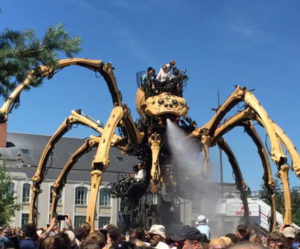
The mechanical Great Elephant is the star of the place (see top photo), and the gallery of machines showcases a true menagerie of weird and wonderful beasts: a giant, surreal mechanical spider, ant and heron, just to name a few. Book a ride on the Giant Elephant on the internet beforehand to avoid the lengthy queues.
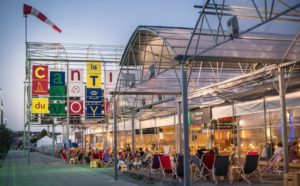
There’s a huge open-air café, La Cantine du Voyage, on Quai des Antilles. It’s one of the most enjoyable days we’d spent in a very long time!
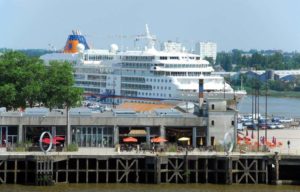
Also on the Île de Nantes, is La Hangar à Bananes, a huge former warehouse where bananas imported from the West Indies were once brought to ripen. The HAB, as it’s now known, is a brilliant contemporary art venue, while at night there are bars and concerts. Visiting this former industrial wasteland in the middle of the Loire, it’s hard to imagine it as the virtual no-go area it became after the shipbuilding ceased in the 1980s.
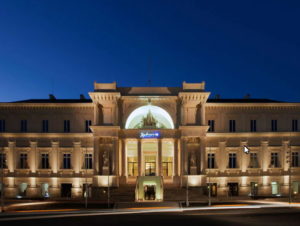
If you’re looking for somewhere interesting to stay in the centre of Nantes, check out the Radisson Blu Hotel, where we stayed on our last visit to the city. The hotel occupies a beautifully renovated neoclassical former Palais de Justice (Court House) that served as the Nantes Law Courts until 2000.
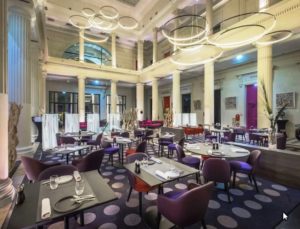
The hotel imaginatively blends contemporary, modern style and comfort while retaining many features of its former function. For example, the former court room is now the main restaurant. It’s yet another of the numerous historic buildings in Nantes that have successfully been adapted to a new use.
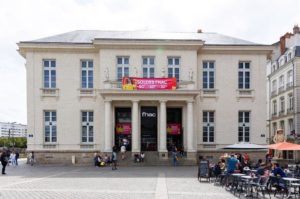
Nantes is an interesting starting point for a visit to the Loire Valley. It’s easy to get to from Paris by train, with frequent direct trains from Montparnasse taking a little over 2 hours, or around 4 hours by road using the motorways. Although no longer officially a part of Brittany, Nantes has retained its Breton feel and many traditions. This very interesting small city is well worth a couple of days, so take your time to relax and soak up its atmosphere and fascinating history.
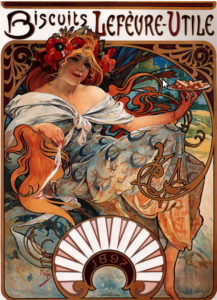


Particularly love the sea snake and the spider.
And as always, fascinated by the history.
Well done.
It’s the most extraordinary place. Originally set up to make electronic “things” for the film industry and has since taken on a life of its own. Yes, love the spider, and also the dragon, but to see the giant elephant sauntering along, with people on board for the ride, and the huge trunk spraying forth water onto the crowds at intervals is quite a hoot! Nantes itself was a terrific surprise to us, thoroughly enjoyable, and we plan to go back one day very soon.
I just love your posts Cheryl and have learned so much from them. Thank you. v best Sarah
Hi Sarah,
Lovely to hear from you! So delighted that you enjoy the posts–I enjoy writing them, and it’s just a small way of keeping in touch with favourite destinations. If you’ve not been to Nantes before, or perhaps fancy the idea of exploring the Loire, it’s a great place to start from, as it puts the region somewhat in perspective. Won’t it be terrific to be able to travel again–hopefully one day soon!
Cheers,
Cheryl